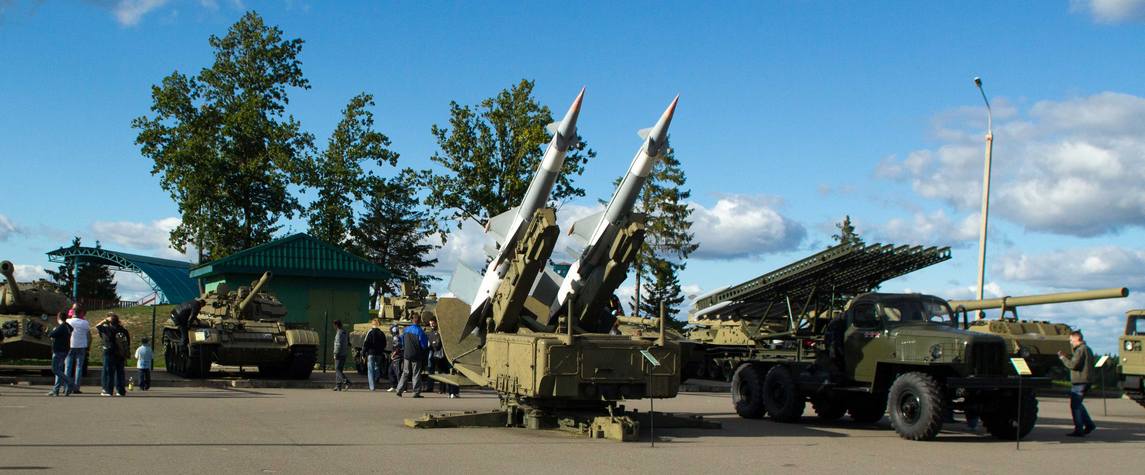About Stalin Line
The name “Stalin line” became official only with the opening of the museum. The system of fortifications was called this way by the western press, first of all, in Germany. The name appeared on the analogy of the well-known long-term fortifications: “Maginot line” in France, “Siegfried Line” in Germany, “Metaxas Line” in Greece and “Mannerheim Line” in Finland. In the first half of the 20th century many European countries were drawn in the so-called “fortification fever” – they fortified their borders.
Use the opportunity to shoot with the real guns. There are Mosin’s rifles, machine-gun “Maxim”, Kalashnikov’s submachine and RPD machine-gun (light machine-gun of Degtyaryov) – and it is only a small part of the collection.
There in the on-site restaurant the Belarusian national cuisine is served, but those, who want to plunge into the atmosphere of wartime, can refresh themselves with the nourishing soldier’s porridge in a field tent.
Near the main gates of the museum, across P28 highway, there is another blockhouse left from the line of fortifications. In contrast to those in the territory of the museum, it’s desolated. However, it’s possible to feel the difference between the original and restored fortifications.
What to see
In the area of military equipment there is a vast collection of military artifacts. There you can see the well-known fighting machine “Katyusha”. It’s believed that its nickname was given by the Soviet soldiers according to the name of a song famous before the war. But there are other versions: the most probable one is associated with the index “K” on its body. Self-propelled artillery unit ISU-152 named after Joseph Stalin is also of no less interest. Such units were widely used in the Belarusian offensive operation “Bagration”, they helped greatly in the battles for Vitebsk and Polotsk. Another amazing exhibit is a self-propelled howitzer “Acacia” that is able to accelerate up to 60 km/h. In the territory of combat vehicles there are also heavy Soviet tanks, armoured personnel carriers and crawler tractors, armoured reconnaissance and patrol vehicles, armoured troop-carriers and well known 45 mm anti-tank guns.
In the area of aerotechnics there is an outstanding aircraft of that time – reconnaissance-bomber MiG-25. It’s the world’s first serial fighter that managed to reach the speed turn of 3 thousand km/h. Also it holds the absolute flight altitude record of 37,650 m. This type of artifact set 29 world records.
In the territory of the Historical and Cultural Complex “Stalin Line” there is 3-embrasured machinegun blockhouse No. 292 built in 1932. One and a half metre walls ensured protection against the hits of howitzers and cannon shells, but the traces of German shells have still remained on the outside walls of the fortification. There was a system of cooling water and removal of powder gases, shortwave radio-station and telephone as well. Ammunition of each gun was provided by 30 thousand cartridges; up to 250 shots could be made per minute.
The centre of attention of “Stalin Line” is focused on famous tanks T-34 reasonably considered the best tanks of World War II. The legendary T-34-85 is also there. This tank model was mass-used during the operation “Bagration” and participated in the battles of the final stage of World War II. The visitors can ride this tank.
On the site of air defence there is an impressive 22-metre ballistic missile with a maximum flight range of 2 thousand km. Moreover, there are surface-to-air missile systems, operational-tactical and radar systems, formidable anti-aircraft artillery complex KS-19 that is capable of hitting the targets moving at speed up to 9 hundred km/h.
On our website you can order a taxi to "Stalin Line". We have modern and comfortable cars. In each car there is a Wi-Fi. Travel with Transfer Service!!
- Tuesday - Sunday: 10.00 — 18.00
- Day off: Monday
- +375-17-512-12-33
- +375-44-716-34-59
- +375-44-716-34-69

